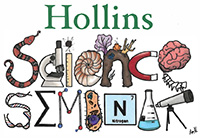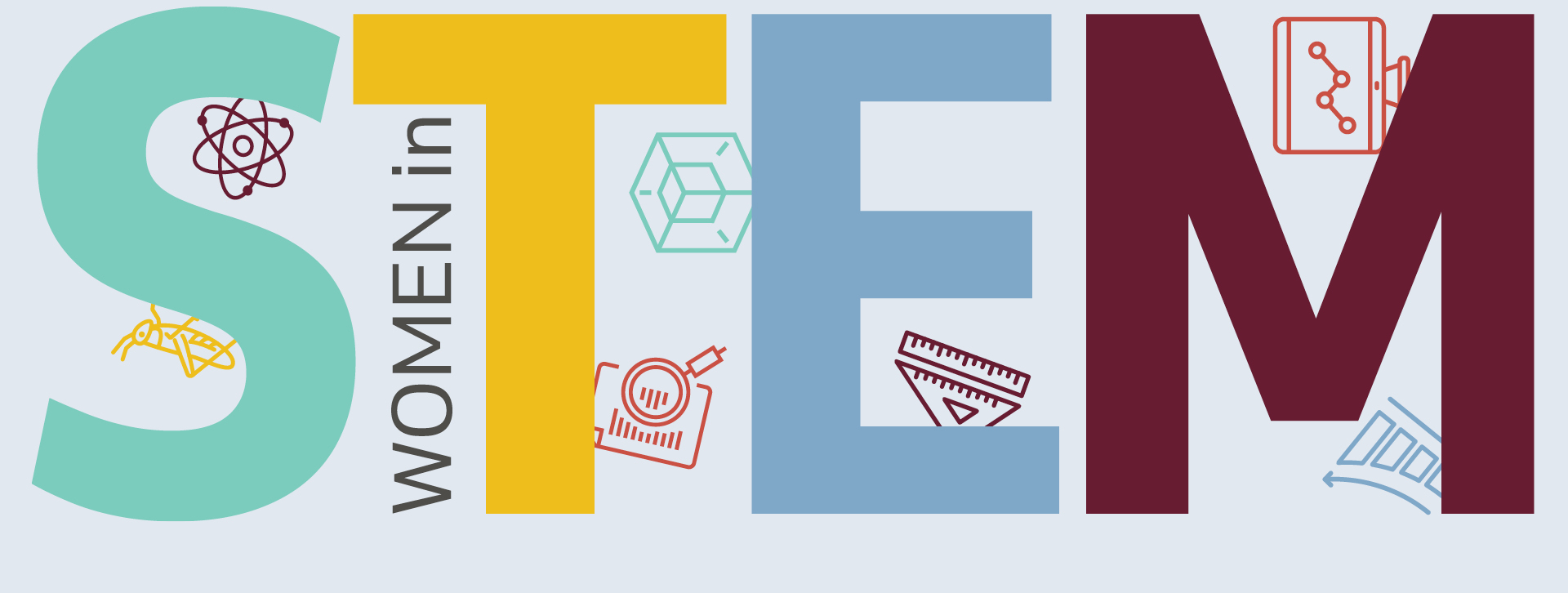Women in STEM
By Sarah Achenbach ’88
Data doesn’t lie. Women comprise a mere 28% of the STEM (science, technology, engineering, and math) workforce. In the lucrative and growing computer science/math and engineering fields, women make up only 25.2% and 16.5%, respectively. (Source, U.S. Bureau of Labor Statistics, 2020.)
Hollins STEM students, faculty, and alumnae/i are making sure that the data is moving in the right direction. STEM majors are thriving at Hollins. For all majors for the academic year just finished, psychology and biology are the number one and two majors, respectively. Chemistry rounds out the top 10 at number nine, with environmental studies, mathematics, and public health tied for 12th.
When Scientific American conducted its own study of common traits among female STEM leaders in 2020, the qualities they found successful women in STEM share—confidence, ensuring their ideas are heard, authenticity—are just another day in Hollins’ Dana Science Building (or any other classroom on campus). The alumnae/i STEM leaders profiled here have taken their passion for STEM, nurtured at Hollins, to become pioneers in their fields.
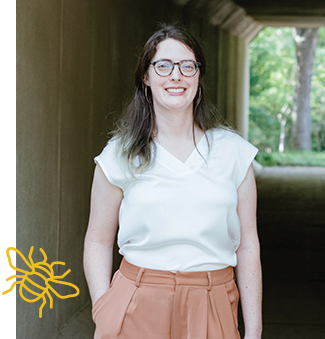 NICOLE PARKER ’09
NICOLE PARKER ’09
Program Specialist, U.S. Department of Agriculture
B.S., biology and environmental science
M.S., entomology, Purdue University Wildlife and Wildlands Science and Management, The School for Field Studies
Peace Corps, Zambia
I’ve always liked insects. I had no idea you could make a career out of bugs. For study abroad, I went to Tanzania, where there are a lot of crops. What affects crops? Insects. I wanted to do something to make an impact, so I decided to become a field agricultural entomologist and focus on global sustainable farming.
My goal from the start has been to decrease food insecurity in a sustainable way that bridges the gap between research and everyday life. I was in the Peace Corps in Zambia for two years, doing agri-forestry and helping local communities become more self-sufficient and sustainable. We worked to make them more independent in ways that protected essential resources like tree planting versus deforestation.
I had an entomologist’s dream job. I was program director for the largest sterile insect release program in the world at the U.S. Department of Agriculture’s Animal and Plant Health Inspection Service. I worked in Guatemala and Mexico on acceptable strategies that protected American agriculture. After two years I returned to the States. The entomology field here is highly focused on pest management, typically sales and treatment. So I pivoted to a new career in food and nutrition service.
I love figuring out what tools and processes we need to solve the problem. I work in retailer compliance and examine retailer transaction data to determine whether they are violating regulations and committing fraud within the program.
Science is ever changing. You’re always questioning, coming up with new theories and how to test them, and looking at
information and then adapting to that. [As a female scientist], I think there’s still the challenge that you’re not necessarily taken at face value. I’ve always had female colleagues, and we’ve supported each other with new ideas. Entomologists can be very independent, but building relationships is really going to help you advance your ideas.
Pest management is definitely going to be a big deal as climate change continues. Sterile insect techniques are starting to be applied to more scenarios. Medicine is using it to combat mosquitoes that spread disease. There is also insect farming for proteins to try to move away from traditional beef, for example. GPS technology is being used to track insect movement, so learning computer programming is really beneficial. It’s also transferable to other sciences.
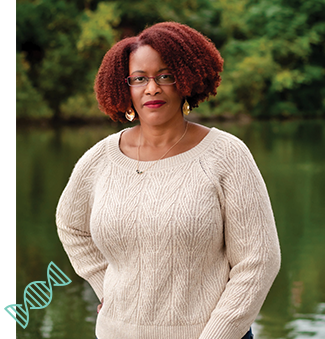 ANTOINETTE HILLIAN ’00, Ph.D., CCRP
ANTOINETTE HILLIAN ’00, Ph.D., CCRP
Clinical Scientist, Parexel
B.S., biology
Ph.D., genetics, Case Western Reserve University
Certified Clinical Research Professional (CCRP)
Hollins Alumnae Board, member since 2016; President, 2021 to 2023
I chose Hollins because I wanted a career in genetics research. I attended Hollinsummer (then “HollinScience”) before my junior year and loved everything about the STEM offerings. Between that, Hollins’ small class sizes, and attentive faculty, there was nowhere else I wanted to go. My first job out of college was helping to sequence the genome of a fungus that destroyed rice crops. My graduate work was studying genetic mutations that affected the disease severity of cystic fibrosis. For my postdoctoral work, I studied the effect of a high-fat diet on insulin resistance and glucose levels in mice.
After 12 years of doing lab research, I had an epiphany that I didn’t actually like lab-based research, but everything else surrounding it. I switched over to clinical research operations. When I am examining data and sending emails to make sure the data is clean and sites are compliant with the protocol, our overall goal is to share good research: that what is ultimately sent to the FDA is safe, quality data.
I’m a clinical scientist for a large phase III kidney cancer study. I review patient data from around the world and ensure that research sites are compliant with the study protocol and that patients are safe. As a Black woman, part of a group who has been unfairly treated by medical research, I’m proud of the role I play in ensuring safe trials and ultimately safe medication.
I founded the STEMinist group to mentor students and new Hollins alumnae. The LinkedIn group connects them with older alumnae in STEM for networking advice. There’s so much you can do with a STEM background. I tell [students and young alumnae] to be open to new opportunities. I was very focused on becoming a Ph.D. doing lab science in genetics. Looking back now, it wasn’t a good fit for me. I need to be true to who I am. It’s okay not to have everything figured out. You will find your path.
Clinical trials can be the last chance for a lot of patients. CAR T-cell immunotherapy is a huge breakthrough for stem cell research. It’s proving to be very successful in subjects who have failed earlier conventional treatments. I’m proud that my hospital opened one of the first trials for lymphoma in the country.
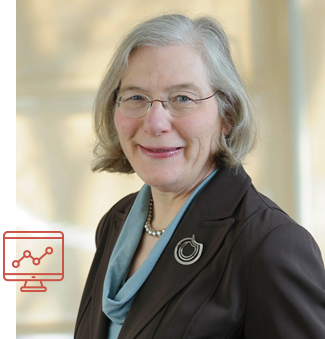 ANN GRAHAM ZAUBER ’69, Ph.D.
ANN GRAHAM ZAUBER ’69, Ph.D.
Member and Attending Biostatistician, Department of Epidemiology and Biostatistics, Memorial Sloan Kettering Cancer Center
B.S., statistics
Ph.D., biostatistics, Johns Hopkins University
At the end of my sophomore year, I was a chemistry major. That summer, I was part of a research program at the University of Alabama Medical School doing lab work for pediatrics. I enjoyed designing the project more than being in the lab, so I changed my major to statistics. For most places, statistics was offered in graduate school, not undergraduate, so it was really a jewel for Hollins to have a statistics major.
I’ve been blessed with opportunities. [After graduating] I went directly into a Ph.D. program at Johns Hopkins University. Most of the people there already had one or two masters’ or had worked in Pharma. After my husband’s medical residency in New York in the early 1970s, I returned to Hopkins in an emerging field with a whole new kind of statistics: health services, which included screening programs like mammograms and vaccinations. I did a post-doc in epidemiology, working on breast cancer treatment with a randomized clinical trial in Pittsburgh during my husband’s fellowship. When we settled in New Jersey, people recommended that I contact the head epidemiologist at the Memorial Sloan Kettering Cancer Center, who was working in cancer epidemiology and cancer prevention and control. I’ve been working there for 43 years now.
Biostatistics uses data to direct hypothesis. You have a hypothesis that the element or drug will cure cancer or reduce mortality. Statistics are the data, but the science of statistics is the design of how you’re going to relate what you observe. One of our first projects was the National Polyp Study looking at people who had already had adenomas, a precursor lesion for colorectal cancer. There was a randomized trial to see how often they needed to be seen using colonoscopy. That’s how I started with colon cancer biostatistics. We use microsimulation modeling to assess the growth of adenomas and to predict the occurrence of colorectal cancer. Using these models, we can efficiently examine the most optimal screening and surveillance practices to reduce the burden of colorectal cancer.
You always need to have good data and good methodology. I’ve worked with the U.S. Preventive Services Task Force, the American Cancer Society, and the Cystic Fibrosis Society on screening recommendations, such that screening tests are conducted in the most efficient time intervals. We’re working on the possibility of a blood test, rather than a fecal test, for colon cancer. The computing power we now have is spectacular and ever-growing. Our first randomized trial had 2,000 people. Now we have big data with 100,000 people. We’ve really changed the tune of screening for colon cancer, from small, randomized trials to the big data and different ways for people to get screened.
 JULIE FISCHER ’92, Ph.D.
JULIE FISCHER ’92, Ph.D.
Technical Director, Global Health, CRDF Global
B.S., biology, B.A., English
Ph.D., microbiology and immunology, Vanderbilt University
Postdoctoral fellowship, University of Washington and the Seattle Biomedical Research Institute
Public health is a discipline that’s a century old, but I didn’t really think about it as being a career pathway in college. I began in the laboratory sciences with a very traditional research degree and postdoc before I got to public health. I’ve always been interested in how you use science to query how the universe works and how to apply it to make systems and interventions that make people safer and healthier and our planet more sustainable.
I thought I would be a veterinarian. My Short Term at a veterinary research institute at the University of Kentucky was transformational. I loved the research piece and diverted my interest to veterinary research. Then I started thinking that there were so many diseases and health conditions affecting people. I wanted to do research that had a chance of addressing HIV and AIDS. My early research was on better understanding how HIV causes disease progression. At Hollins, Professors Harriet Gray [biology] and Sandra Boatman [chemistry] made me more disciplined and encouraged me to think about what I wanted to do in research. My takeaway from my liberal arts education is that I can always learn new things. When you get to your goal, you don’t stop. You keep building on it. That’s a fantastic foundation for a career in global health, which is constantly evolving and changing.
My career in public health grew out of opportunities. I did a postdoc in viral pathogenesis, very research-focused, inquiry-driven work. I had an opportunity to work on viral diseases with the Centers for Disease Control and Prevention (CDC) in the U.S., and with the CDC in collaboration with the Thai Ministry of Public Health. I worked in laboratory capacity building to make sure the labs in two Thai provinces had the equipment and materials they needed and that the [lab staff] had the needed training to detect and diagnose diseases that cause pneumonia. I’ve spent almost 20 years now working on variations of disease surveillance in public health with a focus on global health.
I came of age when HIV/AIDS was becoming a pandemic. The public health community predicted and warned about the idea that we were vulnerable to the spread of emerging infectious diseases. We don’t have to wait for the next event, outbreak, or emergency. For me, public health combines social justice with health and science.
During the COVID-19 pandemic, I was in academia. I investigated what it takes to build capacity to detect and respond rapidly to outbreaks. Now I’m the technical director of the CRDF Global portfolio CDC-funded projects, which means working with people in partner countries to help assess how to detect outbreaks quickly and respond effectively when they occur.
We cannot conduct disease surveillance one country at a time. We learned from the COVID-19 pandemic that we need to work together and share information to forecast more effectively. With technologies in place, we can diagnose epidemic-prone diseases and unknown and emerging diseases more rapidly. If we build on these platforms and build the trained workforce, then we are better prepared.
I’m encouraged by the growing call to decolonize global health. We are starting to think about what is most needed from the local perspective, not what the most resourced countries think is needed. When we start thinking more comprehensively and collaboratively, we move forward together.
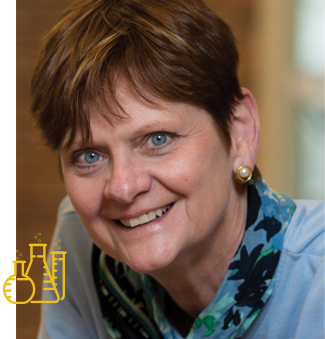 DEBRA PEATTIE ’75, Ph.D., M.B.A.
DEBRA PEATTIE ’75, Ph.D., M.B.A.
Managing Partner, SV U.S. Operations
Entrepreneurial strategist for STEM start-ups
B.S., chemistry
Ph.D., biochemistry and molecular biology, Harvard University
Helen Hay Whitney Postdoctoral Fellow, biochemistry, Stanford University
M.B.A., Harvard Business School
I fell in love with chemistry in 10th grade. When I applied to Hollins, the Dana Science Building was new. I took one look and knew it was for me. Professor Ralph Steinhardt was head of the chemistry department and he gave me free rein of the building, night or day. He said to follow my passion and that’s what I have done. I went straight to Harvard after Hollins.
The common denominator in all my professional undertakings is that they are all new initiatives. After my Ph.D. at Harvard and my postdoctoral work at Stanford, I returned to Harvard as an assistant professor at the medical school. I had received my first National Institutes of Health (NIH) grant only after generating data to convince the NIH that I could do what I was proposing. That process made me realize that the government is not going to pay me to innovate. It’s going to pay me to do things that I know how to do. I decided that wasn’t going to work for me. The whole point of science is trying things, and sometimes they work and sometimes they don’t.
My first start-up with Vertex Pharmaceuticals worked. Today, they are light years away from what they were founded on, which was structural drug development based on small molecules. Now they’re into cell therapy and gene therapy and all kinds of fabulous things. One of the companies I founded that did not work out was one trying to develop a blood diagnostic for endometriosis. The science was there, but not the technology. I learned to move on from failure because something else will work.
I love the technology of science. With RNA therapeutics emerging, technology is offering tools to go forward that we didn’t have in the past. Of course it has raised ethical and cost concerns. The more advanced we get, the harder things often become to move forward in other ways.
SV Investments is trying to build cross-border opportunities. SV stands for Strategic Value. It’s a private equity and venture capital firm in South Korea with assets of $1.5 billion. SV has established a partnership with a Boston-based firm to expand on the U.S. footprint to offer Korean investors access to U.S.-based investment opportunities in life sciences. One of the legacies of the COVID-19 pandemic is that now you can tap into expertise in a way that is efficient for everybody’s time. This fosters collaboration and creativity because you have access to people, their ideas, and information much more readily than when everything had to be done in person.
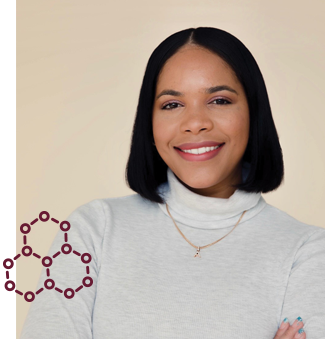 ASHANI DAVIDSON ’17
ASHANI DAVIDSON ’17
Manager, Global Makeup Product Development, The Estée Lauder Companies
B.S., biology with a biochemistry concentration, dance minor
Hollins Batten Leadership Program
M.A., cosmetics and fragrance marketing and management, Fashion Institute of Technology
I was pre-med at Hollins. Spring of my senior year, I wasn’t ready to fully commit to medical school. I like to use both my right and left brain. I like to be analytical and creative. I felt that going to medical school would have taken that away from me, but I didn’t know how to shift or pivot earlier.
I never thought about beauty as a career path. At the Hollins Science Seminar, I presented my research on my own skincare product that inhibits the growth of acne. Alexandra Trower ’86 [Hollins Board member and, at the time, Estée Lauder’s Executive Vice President for Global Communications] was in the audience and asked if I had thought of doing something in beauty. Two months before graduation, I went to New York, met with her, and applied for a job as an associate scientist. I decided I would work in beauty for at least the first year and then see how I felt about going to medical school.
You don’t see STEM jobs in the beauty industry advertised that often. Before applying to Estée Lauder, while I was trying to figure out if I should go to medical school, I was thinking about how to make a product. How do I work with different formulators to tackle the problem in a different way? I like having creative control. When I started, I worked in the clinical center testing the efficacy of products. I moved into formulation in the lab, then into product development and innovation. I communicated closely with my research and development lab and helped my team put together a test plan to bring new ideas to life. In my current role in branded product development, I lead all the face makeup product development for the Lauder brand. Even now that I am in marketing, I still use my STEM background. Everything that we do, I ask, what is the methodology? What’s gonna be our key insight? How are we going to use data to support our story?
Beauty is very personal for a lot of women. People might think, “Oh, it’s just lipstick,” but it gives women confidence. It’s not just outward. It’s inward, too. I take beauty development seriously because I know a lot of women take their beauty regimen seriously. And as a woman of color, I feel it’s my duty to ensure that everyone feels included. I look at shade lineups to ensure that everyone is captured when it comes to the shades that we develop.
Biotechnology is going to be used in the next couple of years, especially in beauty. Anyone can go to a store and buy a cream, but when you look at your body, we eat differently, we sleep differently, we manage stress differently. Women have hormones that are released differently. Right now in the market, we don’t look at that holistically. Using biotechnology or even artificial intelligence (AI) or hybrid intelligence, which is that mixture of AI and human intelligence, to pull data from a specific person, look at their entire genetic makeup, and then make something that’s super personalized just for that person—that would be a game changer for beauty. Each person’s skin microbiome is different. It’s not a one size fits all. How do you use technology to enhance and make personalized products for people?
Read about the 65 year history of the Hollins Science Seminar.
